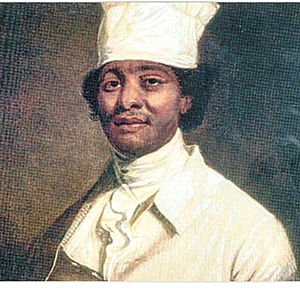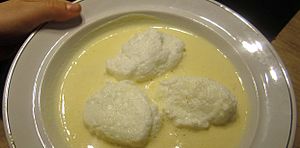James Hemings facts for kids
Quick facts for kids
James Hemings
|
|
|---|---|

Painting by Rembrandt Peale
|
|
| Born | 1765 |
| Died | 1801 (aged 35–36) |
| Nationality | American |
| Occupation | Chef de cuisine, cook |
| Parent(s) | Betty Hemings John Wayles |
| Relatives | Hemings family |
James Hemings (1765–1801) was the first American to train as a chef in France. He was African American and born in Virginia in 1765. At 8 years old, he was enslaved by Thomas Jefferson .
He was an older brother of Sally Hemings and a half-sibling of Jefferson's wife Martha Jefferson, with whom he shared John Wayles as father. It was said that Wayles had taken James's mother, who was his slave, as his mistress. Being his slave, she could not consent and the term mistress may be misleading. As a young man, Hemings was selected by Jefferson to accompany him to Paris when the latter was appointed Minister to France. There Hemings was trained to be a French chef; independently, he took lessons to learn how to speak the French language.
He returned to the United States with Jefferson, likely because of kinship ties with his large Hemings family at Monticello. Jefferson continued to pay Hemings wages as his chef when he worked for Jefferson in Philadelphia. Hemings negotiated with Jefferson for his freedom, which he gained in 1796, after training his brother Peter for three years to replace him as chef. Hemings died at age 36.
Biography
Early life
James Hemings was born into slavery to Betty Hemings, who was the mixed-race daughter of an enslaved African mother, and an English sea captain father whose surname was Hemings. James was the second of her six children by her enslaver John Wayles, who took Betty as a forced concubine after he was widowed for the third time. This situation lasted for 12 years, until his death, and he had six children with her. They were three-quarters European by ancestry. Betty had four older children by another man. Wayles died in 1773, leaving Betty and the 10 children to his daughter Martha Jefferson, half-sister to his children by Betty. Martha was then married to Thomas Jefferson, who became their enslaver by marriage.
In 1784 Thomas Jefferson took James Hemings with him when he went to Paris as Minister Plenipotentiary to the Court of Versailles, as he wanted the young man, then 19, trained as a chef. While they were in France, Jefferson paid Hemings a wage of four dollars per month. For the first three years, Hemings studied cooking and apprenticed to pastry chefs and other specialists, including the chef of a prince. He paid personally to learn the language from a French tutor. He earned the role of chef de cuisine in Jefferson's kitchen on the Champs-Élysées. He served his creations to the European aristocrats, writers and scientists whom Jefferson invited to dinner.
Career
It was during his time in France that Hemings learned the French dish of pasta and cheese. He prepared a dish called "macaroni pie". This dish evolved to what Americans call macaroni and cheese today. James is believed to be one of the first American chefs to prepare the original French dish in this way. However, credit is often incorrectly attributed to Thomas Jefferson's cousin, Mary Randolph, as it was later included in her seminal housekeeping book, The Virginia House-Wife. Another dish James introduced to American cuisine is Snow Eggs, which is originally French and consists of meringue and custard.
In Paris, Jefferson became concerned that Hemings might learn that he could be free when France had abolished slavery in 1789. He wrote about this issue to another American enslaver in a similar situation. According to the 1873 memoir of Madison Hemings, his uncle James and (future) mother Sally actively considered staying in France for freedom while they were in Paris. (Sally Hemings had accompanied one of Jefferson's daughters to France and worked for the family until they returned to the United States.) While fearful of their seeking freedom, Jefferson, who was in debt for most of his life, was also concerned about having paid for training James.
In 1789, however, both the Hemingses returned to America with Jefferson; he continued to pay James wages to work as his chef. They first returned to Monticello. They lived briefly in a leased house on Maiden Lane in New York City (when the national government was based there), where James Hemings ran the kitchen. In the spring of 1791, when James Hemings and Jefferson were resident in Philadelphia, then the capital, the young enslaved man accompanied Jefferson and James Madison on a month-long vacation in the Northeast. The party traveled through New York and Vermont, stopping at Albany, Lake George, Lake Champlain and Bennington. Jefferson often entrusted Hemings to travel alone ahead of the others to arrange accommodations along the way. After returning south through western Massachusetts and Connecticut, Jefferson and Hemings returned for a long-term stay in Philadelphia.
As Pennsylvania did not allow slavery, Jefferson paid Hemings a wage while he worked there. After two years in Philadelphia, Jefferson made plans to return to Virginia. Reluctant to return to a slave state, Hemings negotiated a contract with Jefferson by which he would gain freedom after training a replacement chef at Monticello to take his place.
In the 1793 agreement, Jefferson wrote:
Having been at great expence in having James Hemings taught the art of cookery, desiring to befriend him, and to require from him as little in return as possible, I hereby do promise & declare, that if the said James should go with me to Monticello in the course of the ensuing winter, when I go to reside there myself, and shall there continue until he shall have taught such person as I shall place under him for that purpose to be a good cook, this previous condition being performed, he shall thereupon be made free ...
Considering that Hemings had served Jefferson well for years, some historians have described this as a grudging manumission.
For two years, Hemings trained his younger brother Peter, also enslaved from birth, as chef at Monticello, and finally gained his freedom in 1796. He spoke French and English and was literate; his handwritten inventory of kitchen supplies made before he left Monticello is held by the Library of Congress. He also left recipes and other writings. After traveling to Europe, Hemings eventually returned to the United States, where he found work as a cook in Philadelphia.
Little is known about Hemings' personal life. He never married, nor did he have children. One of the difficulties in imagining his life outside of Thomas Jefferson, is that there is a scarcity of authenticated and preserved sources that are directly traceable to him. One of the only sources that is directly traceable to James, is a handwritten list of kitchen utensils.
In 1801, Jefferson offered Hemings a position at the White House, which Hemings declined, as he felt he could not immediately leave his position in Baltimore. When Jefferson inquired a second time, Hemings responded through an intermediary, Francis Sayes, who had worked with Hemings when they were in New York and in Philadelphia. Sayes reported, "I have spoke to James according to your Desire he has made mention again as he did before that he was willing to serve you before any other man in the Union but sence he understands that he would have to be among strange servants he would be very much obliged to you if you would send him a few lines of engagement and on what conditions and what wages you would please to give him with your own hand wreiting." Jefferson did not write Hemings, reasoning that he did not want to "urge him against inclination." Hemings later returned briefly to Monticello, working for a month and a half in the kitchen and earning thirty dollars before leaving. Later, while employed as a cook in a tavern in Baltimore, he died at age 36.
On November 9, 1801, Jefferson wrote from Washington, DC, to James Dinsmore, the Irish joiner managing much of the construction at Monticello, recounting the circumstances of Hemings' death, presumably with instructions to tell his mother Betty and his brother John, who was Dinsmore's assistant. On December 4, 1801, Jefferson wrote to his son-in-law, Thomas Mann Randolph, characterizing Hemings' death as a "tragical end."


